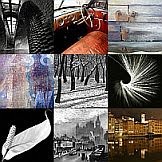I made myself a small one with a piece of glass from a clip frame, which was okay but it had three distinct disadvantages: it was glass and I never really liked leaning on it; the light source was a single point and very poor to work with; and it was no good for working at A3 size. So, by 'okay' I mean 'useless.'
A3 lightboxes can be quite expensive. Depending on type they can start at £35 and go up to about £100. Being the churlish pinchfist that I am I had a look at what I could do to make one myself. In the end, the only thing I needed to buy was the LED strip; I already had the other materials, including the white perspex. Whether you feel it's worth the hassle to save fifty quid or so is up to you, but, for what it's worth, this is what I did.
Materials for an A3 lightbox:
- 5mm MDF board
- Planed wood strip, 30mm x 4mm (whatever dimensions you use you'll need 1.5m of it - A3 perimeter is 143.4cm)
- 6 small woodscrews
- 3m LED strip (self-adhesive) with power adaptor
- white translucent perspex sheet
- quadrant section wooden moulding
- EvoStick wood glue.
 |
| To save you reading any further: a diagram. |
1. The simplest way to deal with the dimensions and right angles is to use the cardboard back from an A3 sketchbook as a template.
The first thing I made was the frame onto which the base board and top perspex would be fixed. I made it 3cm deep as I wanted the profile of the finished box to be quite slim. Also it's what I had in the shed.
I glued two three-metre lengths together to give them a bit more strength, and left these to set overnight in clamps.
Then I used the template to cut them to the correct lengths for an A3 frame (long sides 42cm, short sides 29.7cm, give or take) and put a section of quadrant in the corners for reinforcement. You can clamp this all together while the glue dries but I found that they all sat together snugly enough on a flat surface while I left them overnight to set. The corner quadrants are also where the screws go to secure the base, so at the same time I put two blocks in the middle of the longer sides:
 |
| Corner quadrant and screw block. |
2. Using the A3 card as template, I marked out and cut the MDF board to size. I painted the face going inside the lightbox matt white; white to help diffuse the light and matt so the LED strip would stick securely.
3. Stick the LED strip to the base board.
(I took the photos after I'd made the lightbox but it's easier to attach the LED strip before fixing the base board to the frame.)
A three metre LED strip fits well inside an A3 lightbox. Mine, complete with adaptor, cost just under £13 from eBay.
It has a self-adhesive backing, but as it doesn't lend itself well to tight curves, I anchored them with thin strips of duct tape. (It looks awful but it all gets hidden.) When you start sticking the LED strip down, start with the end that has the the power wires and fix it in one corner of the board, near the frame.
 |
| LED strip stuck to base board and base board screwed to frame. |
You can now tell where the LED power cables go and you can cut a slot in the frame to allow them to pass through:
 |
| Slot cut for power lead. |
 |
| The power jack: the cables are secured into it by tiny screws; one wire has become detached already in ordinary use. |
4. I then drilled countersunk holes in the corners and sides of the LED base board and attached it to the frame with small wood screws.
5. Now the perspex drawing surface. Again, the A3 card is the template. The perspex can be cut using a craft knife and a metal edge, or, if you're feeling rowdy and adventurous, with a jigsaw - but very slowly and carefully otherwise it chews it up and spits bits all over the place.
I fixed the perspex to the frame and baseboard with the bodger's friend, duct tape. It's aesthetically offensive, but easy, secure, and covers any sharp corners and edges left on the perspex sheet.
 |
| Corners cut and folded over. |
 | ||
| Perspex top attached to frame. |
6. In case it wasn't quite true, and to make sure it didn't slip, I put some padding on the base. I used sticky-backed draught-excluder strip, which did the job nicely.
 |
| Foam footing strip. |
7. That's it. Plug it in. This happens:

It is not beautiful, and you wouldn't confuse it with the cabinet making of Thomas Chippendale, but it is strong, light, easy to get back into if anything goes wrong with the LEDs, and most importantly it is a successful and practical working surface.
If you can't get hold of white perspex, before I found I had a sheet I originally used ordinary clear acrylic sheet and painted one side with a couple of thin layers of white acrylic paint; this diffuses the light - not quite as well, but well enough.









